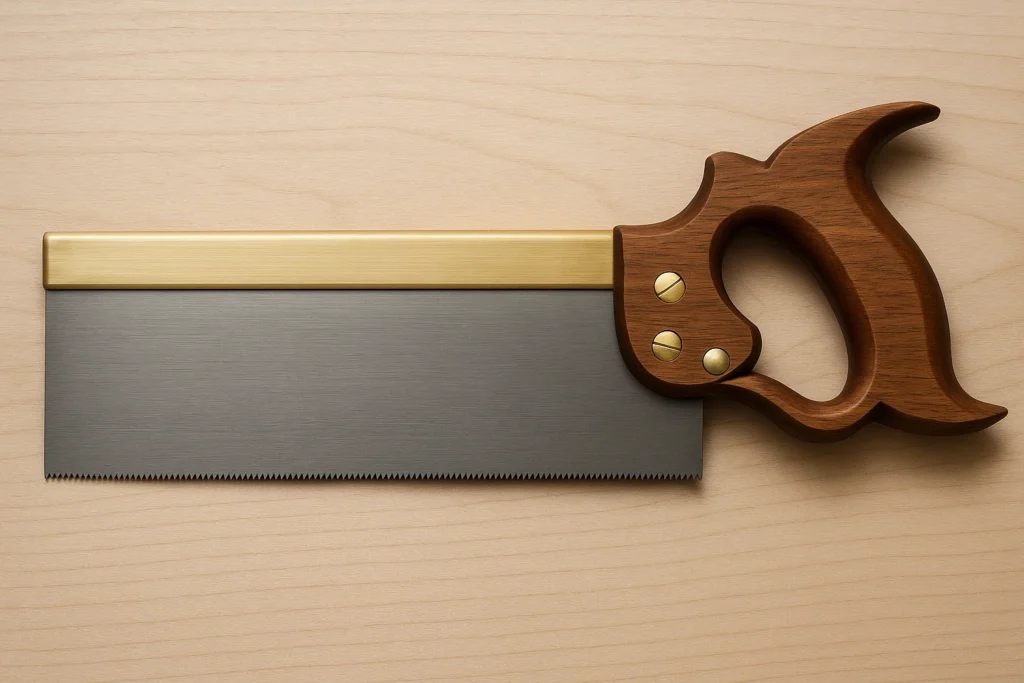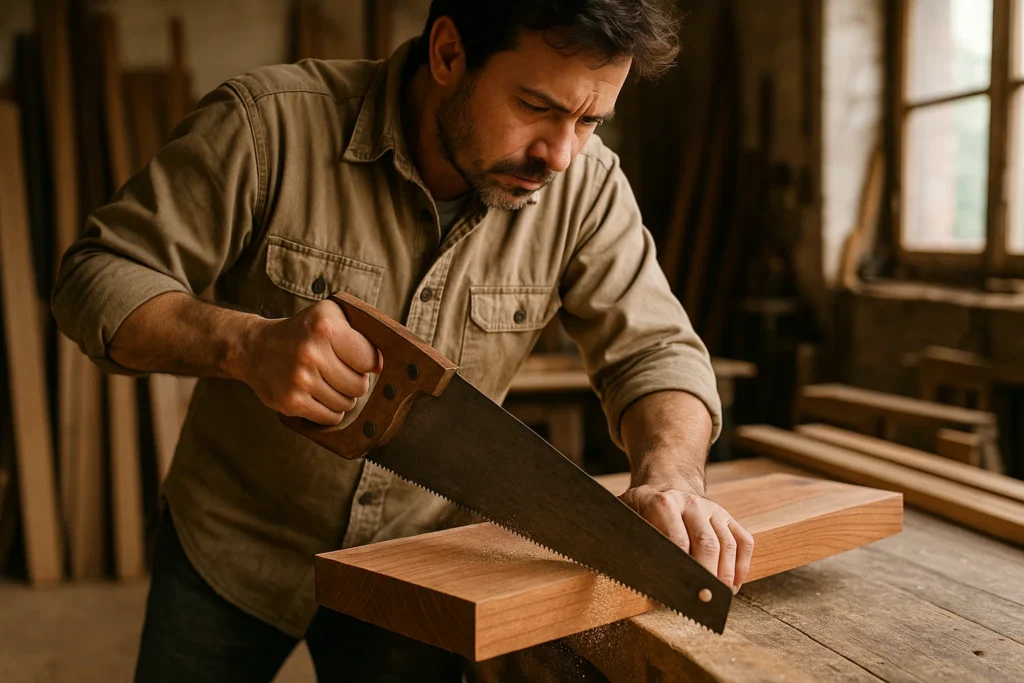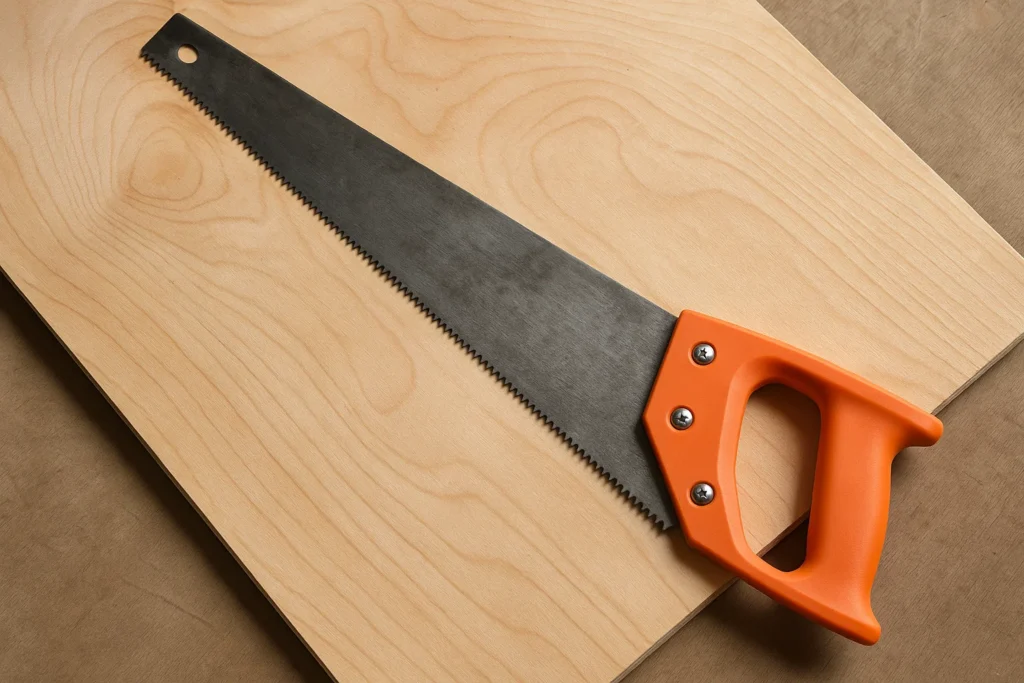The Super‑Skin MK IV coping saw offers precise, fatigue‑free cuts with instant tension control and full 180° blade rotation. Its lightweight frame and included fine blades make it ideal for detailed woodworking.
Bendy Frame, Details Ruined!
Coping saws look simple but can cause big problems if you pick the wrong one.
A weak frame can bend and ruin a cut. Blades that break or slip make your work rough and waste material.
Handles that feel uncomfortable lead to hand pain and less control. Before you buy, think about blade strength, tension, comfort, and the depth you need.
Important Points
- Weak frames bend and ruin precision
- 20–32 TPI blades give smooth, fine cuts
- 14–18 TPI blades cut faster but need more finishing
- Coping saws let you rotate the blade for curves
- Hacksaws are for metal, not fine wood coping
- Quick‑release or large thumbscrew eases blade changes
- Throat depth limits how deep you can cut
- Ergonomic handles reduce hand fatigue and improve control
- Steel frames resist flex, aluminum frames weigh less
- Blade thickness (0.02–0.05 in) balances flexibility and straightness
- Coated blades and frames help prevent rust and wear
- Pick your saw based on tension needs, comfort, and project size
Some Images are generated by AI for illustration.
Best Hand Saws For Coping
Coping Saw | Details | Blade Length | Throat Depth |
|---|---|---|---|
6 in (152 mm) | 6 1/2 in (165 mm) | ||
12-3/8 in (315 mm) | 5‑1/8 in (130 mm) | ||
6 1/2 in (165 mm) | 6 1/4″ in (159 mm) | ||
6‑1/2 in (165 mm) | 5‑1/2″ (140 mm) | ||
5.1 in (130 mm) | 6.3 in (160 mm) |
Note: We don’t test products ourselves. Instead, we go through user reviews and/or community discussions to find and recommend the best options.
1. Super-Skin Knew
The Super‑Skin MK IV coping saw offers precise, fatigue‑free cuts with instant tension control and full 180° blade rotation. Its lightweight frame and included fine blades make it ideal for detailed woodworking.
Key Features
- Blade Length: 6 in (152 mm)
- Throat Depth: 6.5 in (165 mm)
- Frame Material: 3/16 in (4.8 mm) milled aluminum with powder‑coat finish
- Handle Size and Grip: [Not specified]
- Blade Tension Mechanism: large knurled knob plus cam lever for instant tension up to 87 lb (387 N)
- Blade Type and Teeth Per Inch (TPI): Pegas pinned coping blades, 18 TPI, 0.02 in (0.5 mm) thick × 0.094 in (2.4 mm) wide
- Blade Swivel Range: 180° rotation in 45° increments
Pros & Cons
Pros:
- Weight and comfort: Ultra‑light 9.1 oz frame reduces hand fatigue and boosts cutting precision.
- Tension strength: 87 lb tension capacity minimizes blade breakage for uninterrupted cuts.
- Quick blade changes: Cam lever lets you set or release blade tension instantly for fast blade swaps.
- Angle flexibility: 180° blade rotation in 45° steps handles tight corners and angled cuts.
- Out‑of‑box readiness: Includes a dozen 18 TPI Pegas blades for fine work right out of the box.
- Durable finish: Powder‑coat finish resists wear and corrosion in workshop environments.
Cons:
- Cost value: Premium price may be steep for casual users.
- Reach limit: 6 in (152 mm) throat depth limits reach on larger workpieces.
- Blade variety: Only fine‑cut (18 TPI) blades included; coarser blades need separate purchase.
- Ergonomic info: Handle size and grip comfort not specified and may affect ergonomics.
- Storage need: No blade storage or carrying case included; added accessory required.
Note: These pros and cons are based on user review trends and latent consensus.
Our Verdict
A top choice for fine coping work thanks to its precision and ease of use.
Buy If:
- You need quick blade changes with instant tension release.
- You value a lightweight saw to reduce hand fatigue.
- You make tight curves and angled cuts requiring blade rotation.
- You want high tension capacity to cut without blade breakage.
- You appreciate a kit that includes fine 18 TPI blades.
Don’t Buy If:
- You often work on large pieces needing more than 6-1/2 in depth.
- You need coarser blades for rough or fast cuts.
- You’re on a tight budget and can’t justify a premium price.
- You require a saw with a known ergonomic handle design.
- You need onboard blade storage or a carrying case.
The Super‑Skin MK IV coping saw excels at precision fretwork and dovetail waste removal, offering instant tension control and full 180° blade swivel.
Its light frame and included fine blades deliver immediate value for serious woodworkers, though the price and depth limit may deter casual users.
2. ECLIPSE Coping Saw
Eclipse’s 70‑CP1R coping saw pairs a rigid steel frame and comfortable wood handle with 360° blade rotation for precise cuts, though occasional tuning may be needed out of the box.
Key Features
- Blade Length: 12-3/8″ overall length (Blade length not mentioned)
- Throat Depth: 5‑1/8″ (130 mm) throat for deeper cuts
- Frame Material: Steel frame for rigid support
- Handle Size and Grip: Wooden handle for comfortable control [size unspecified]
- Blade Tension Mechanism: [not mentioned]
- Blade Type and Teeth Per Inch (TPI): 14 TPI, Bimetal blade for wear resistance
- Blade Swivel Range: 360° swivel for angled cuts
Pros & Cons
Pros:
- Sturdy Frame: Steel bow resists bending for precise, controlled cuts.
- Smooth Tensioning: Blade holds firm under pressure without constant retightening.
- Full Rotation: 360° swivel pin enables clean angled cuts without repositioning the saw.
- Comfortable Grip: Wooden handle fits hand well, reducing fatigue during extended use.
- Durable Blade: Bimetal construction offers wear resistance and long service life.
- Versatile Blade Swap: Standard pinned blades change quickly for different materials.
Cons:
- Occasional Bent Frames: Some can arrive twisted and need straightening before use.
- Blade Locking Quirk: Blade can shift unless handle post is tightly secured.
- Inconsistent Blade Quality: Reports of snapped blades under light workloads.
- Shallow Throat Depth: 5‑1/8″ (130 mm) limit may not suit taller trim work.
- Handle Alignment Issues: Misaligned handle/post can impact cutting accuracy.
- QC Variability: Finish and fit can vary, leading to uneven tension or crooked assembly.
Note: These pros and cons are based on user review trends and latent consensus.
Our Verdict
Here’s the bottom line in one sentence.
Buy If:
- You need precise, controlled cuts with a rigid steel frame
- You want 360° blade rotation for angled coping cuts
- You swap blades often for different materials
- You value a comfortable wood handle for longer work
- You’re fine making small tweaks for tension or alignment
Don’t Buy If:
- You need more than a 5‑1/8″ (130 mm) throat depth
- You expect perfect out‐of‐box alignment and tension
- You require heavy‑duty blades without replacements
- You dislike straightening or adjusting your saw
- You’re cutting very thick stock beyond its capacity
The Eclipse 70‑CP1R delivers reliable performance, smooth blade rotation, and good comfort at a fair price, making it ideal for DIYers and carpenters who don’t mind minor QC tweaks. Professionals needing deeper cuts or flawless setup may want a higher‑end option.
3. JORGENSEN Coping Saw
A sturdy, 6 ½" (165 mm) coping saw with a 15 TPI blade and ergonomic, non‑slip handle, plus one spare blade for precise detail work. Tight tension holds the blade firmly but makes swaps a bit tough.
Key Features
- Blade Length: 6 1/2″ (165 mm) for precise cuts on tight curves
- Throat Depth: 6 1/4″ (159 mm) to reach wider workpieces
- Frame Material: Heavy duty steel frame for sturdy blade support
- Handle Size and Grip: 4-3/8″, ergonomic plastic, slip‑resistant for comfortable control
- Blade Tension Mechanism: handle‑turn tension adjuster for quick, tool‑free blade changes
- Blade Type and Teeth Per Inch (TPI): high‑speed steel blade, 15 TPI for fast, clean cuts
- Blade Swivel Range: 360 degree blade rotation
Pros & Cons
Pros:
- Great value: Affordable price without skimping on build quality.
- Secure grip: Ergonomic handle stays non‑slip during long cuts.
- Spare blade included: Extra blade lets you keep working without delay.
- Rigid frame: Tubular design resists bending under normal use.
- Fast, clean cuts: 15 TPI blade slices quickly and precisely.
- Stable tension: Blade holds position firmly throughout projects.
- Multi‑material use: Handles wood, plastic, rubber, and light metal.
- Detail‑work ready: Ideal for small crafts, molding, and scroll cuts.
Cons:
- Tough blade changes: High tension makes installing a new blade hard by hand.
- Frame flex under heavy angles: May bend when cutting thick angles or crown molding.
- Rare hardware failure: Occasional report of handle screw breaking.
- Spare blade count unclear: Packaging suggests two extras but reports of only one being provided
Note: These pros and cons are based on user review trends and latent consensus.
Our Verdict
Here’s the final verdict:
Buy If:
- You want a sturdy, precise coping saw at a low cost
- You do fine scroll or detail work on wood, plastic, or light metal
- You value a non‑slip ergonomic grip for longer cuts
- You appreciate having a spare blade ready
Don’t Buy If:
- You change blades often and prefer tool‑free swaps
- You work with very thick angles that strain the frame
- You expected two extra blades in the package
The Jorgensen Pro Coping Saw delivers solid performance, comfort, and value for most DIY and craft projects. If you can live with a tighter blade‑change process and only one spare blade, it’s a top choice; otherwise look for a model with easier tensioning or more extras.
4. IRWIN ProTouch
A budget coping saw with a sharp blade and comfortable grip, ideal for light-duty trim and craft work. Best suited for casual users who can overlook occasional build issues.
Key Features
- Blade Length: 6‑1/2″ (165 mm) for cutting deep, precise curves.
- Throat Depth: 5‑1/2″ (140 mm) frame depth to reach larger workpieces.
- Frame Material: Flat‑Bar steel frame for maximum rigidity and long‑term durability.
- Handle Size and Grip: Ergonomic triangular ProTouch handle for comfortable, slip‑resistant control [exact dimensions not specified].
- Blade Tension Mechanism: DuraSteel pin tension system for quick, secure blade changes [tension range not provided].
- Blade Type and Teeth Per Inch (TPI): High‑speed steel blade with 16 TPI for smooth, efficient cuts.
- Blade Swivel Range: [not specified in product data]
Pros & Cons
Pros:
- Budget-Friendly: Very affordable price for occasional or hobby use, making it an easy add‑on to any toolbox.
- Fast Shipping Option: Next‑day delivery option lets you tackle urgent small projects without delay.
- Space-Saving Design: Compact, lightweight design stores easily and fits into tight workspaces.
- Comfortable Grip: Ergonomic triangular ProTouch handle eases hand strain during longer cuts.
- Versatile Cutting: Sharp 16 TPI blade cuts through wood, vinyl tile, and even dental guards smoothly.
- Durable Frame: Durable frame holds up to a variety of materials, from sheetrock to PVC pipes.
- Ready Out of the Box: Ready to use out of the box with minimal setup [blade life may vary].
Cons:
- Assembly Issues: Inconsistent assembly can leave blade‑holding pins misaligned, causing kinks.
- Weak Pins: DuraSteel pins can be snapped under adjustment, reducing long‑term reliability.
- Difficult Blade Changes: Blade changes demand extra force, which can be frustrating for some users.
- Short Blade Life: Included blade may dull or break sooner than expected on harder materials.
- Frame Defects: Occasional warped frames require manual straightening before use.
- Limited Blade Compatibility: Limited to 6‑1/2″ blades; thicker or 32 TPI blades may not fit properly.
Note: These pros and cons are based on user review trends and latent consensus.
Our Verdict
A budget-friendly coping saw that delivers—if you get a good copy.
Buy If:
- You need a low-cost saw for light trim, crafts, or DIY jobs
- You want a compact tool that’s easy to store and quick to use
- You prefer an ergonomic grip for better control during fine cuts
- You’re okay with swapping blades as needed for sharpness
Don’t Buy If:
- You need consistent factory quality for daily or pro-level use
- You want quick, tool-free blade adjustments during work
- You can’t risk dealing with misaligned pins or bent frames
The IRWIN ProTouch Coping Saw is a great value for light, occasional use where precision and comfort matter more than perfect factory assembly. Quality control can be hit or miss, but if you land a well-aligned unit, it performs well above its price point.
5. KAKURI Coping Saw
The KAKURI coping saw set includes five hardened blades and a deep‐frame design for clean, versatile cuts in wood, plastic, and light metals. It’s an affordable, easy‑to‑use tool ideal for DIY and trim work.
Key Features
- Blade Length: 5.1″ (130 mm) for accurate, fine cutting
- Throat Depth: 6.3″ (160 mm) to reach deep into large workpieces
- Frame Material: [not specified]
- Handle Size and Grip: Wooden handle sized to fit hand for ergonomic control
- Blade Tension Mechanism: Tool‑free rotating handle lock for quick, on‑the‑fly blade changes
- Blade Type and Teeth Per Inch (TPI): Includes general woodworking, plywood, plastic & light‑metal blades [TPI values not provided]
- Blade Swivel Range: [not specified]
Pros & Cons
Pros:
- Cutting Performance: Ultra‑sharp blades deliver clean, precise cuts on wood, plastic, and light metals.
- Versatility: Five interchangeable blades cover a wide range of DIY and trim‑work projects.
- Grip Comfort: Wooden handle feels comfortable and secure, reducing hand fatigue.
- Control: Lightweight yet sturdy frame supports accurate control during curved cuts.
- Value: Affordable all‑in‑one set lets you start projects immediately without extra purchases.
Cons:
- Blade Labels: Blade markings are in Japanese or Chinese only, making material selection unclear.
- Setup Adjustment: Frame or handle alignment may require manual adjustment out of the box.
- Durability: Blades can bend or lose sharpness quickly under tougher cuts.
- Blade Change: Short tension screw means you must flex the frame to change blades.
- Rust Risk: Frame finish may show surface rust if not inspected before use.
Note: These pros and cons are based on user review trends and latent consensus.
Our Verdict
A budget-friendly coping saw that delivers—if you get a good copy.
Buy If:
- You need a low-cost saw for light trim, crafts, or DIY jobs
- You want a compact tool that’s easy to store and quick to use
- You prefer an ergonomic grip for better control during fine cuts
- You’re okay with swapping blades as needed for sharpness
Don’t Buy If:
- You need consistent factory quality for daily or pro-level use
- You want quick, tool-free blade adjustments during work
- You can’t risk dealing with misaligned pins or bent frames
The IRWIN ProTouch Coping Saw is a great value for light, occasional use where precision and comfort matter more than perfect factory assembly. Quality control can be hit or miss, but if you land a well-aligned unit, it performs well above its price point.
What Is a Coping Hand Saw?
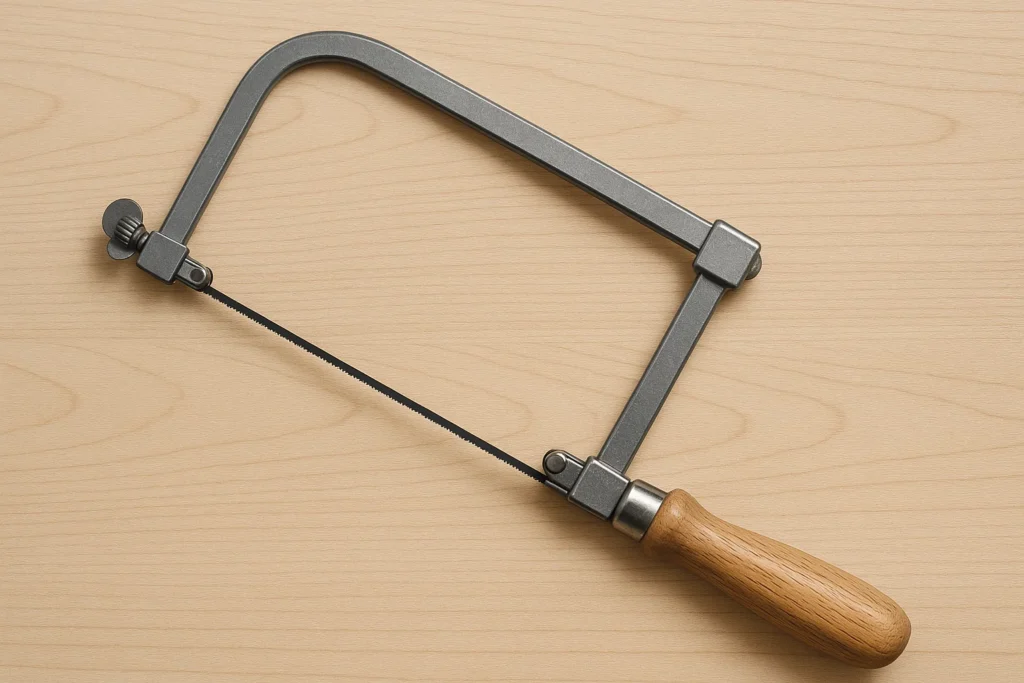
A coping hand saw is a small, fine-toothed saw made for cutting precise shapes in wood, especially to fit pieces together neatly. Here’s what you need to know:
1. Definition and Main Use
- A coping saw has a thin, narrow blade held taut in a U‑shaped frame.
- It is designed to cut curves, corners, and interior shapes—called “coping”—in trim and molding.
- Carpentry tasks like fitting crown molding or baseboard corners rely on its ability to follow tight profiles.
2. How It Differs from Other Saws
- Blade Width: Compared to a standard hand saw, the coping saw’s blade is much narrower (often under 1⁄8 inch).
- Teeth per Inch (TPI): High TPI (usually 20–32) means very small teeth, so cuts are smooth, not rough.
- Frame Design: The U‑shaped frame holds the blade under tension, allowing the user to turn the blade and cut in any direction—unlike fixed‐blade saws.
3. Typical Blade Shape and Size
Feature | Typical Value |
|---|---|
Blade length | 5 to 7 inches |
Blade thickness | 0.02 to 0.05 inches |
Teeth per inch | 20 to 32 TPI |
Frame height | 5 to 8 inches from blade |
Because of its narrow blade and fine teeth, the coping saw glides through wood with control. You can rotate the blade in the frame to follow complex curves without twisting your wrist or ruining the workpiece.
Why Choose a Coping Hand Saw?

A coping hand saw shines when you need exact fits in small trim and molding. Here’s why it earns a spot in your toolkit:
1. Precise Interior Cuts
A coping saw follows the shape of molding profiles. Rather than butting two straight‐cut pieces together, you cut one piece’s profile out so it nestles perfectly against the other.
This removes gaps and keeps corners tight.
2. Ideal for Molding and Trim
- Crown Molding: You can cut the back of a profile to match the shape of the wall and ceiling joint.
- Baseboards: Inside corners fit flush when you cope one piece instead of mitering both.
- Chair Rails and Panels: Any trim with curves or detailed edges benefits from the narrow blade.
3. Control Over Cut Direction
With a coping saw’s rotatable blade, you:
- Turn the handle, not your wrist, to follow curves.
- Cut from the inside out without drilling starter holes first.
- Back‐cut to remove waste wood without overcutting.
4. Why Not a Power Tool?
- Power tools like routers or jigsaws can be faster but less precise in tight spots.
- A coping saw is quieter and safer when detail matters most.
- It costs less and needs no electricity or complex setup.
Choosing a coping saw means choosing accuracy over speed. When your work must look seamless and professional, this simple hand tool delivers cuts that fit like a glove.
Key Features to Look For
Choosing the right coping saw comes down to five main features. Each affects how easy the saw is to use and how clean your cuts will be.
1. Blade Thickness and Flexibility
- Why it matters: Thinner blades bend more easily to follow curves, while thicker blades stay straighter for long cuts.
- What to look for: A blade about 0.02–0.03 inches thick bends well without breaking. If you need straighter cuts in longer stock, pick 0.04–0.05 inches.
2. Tooth Count (TPI) and Shape
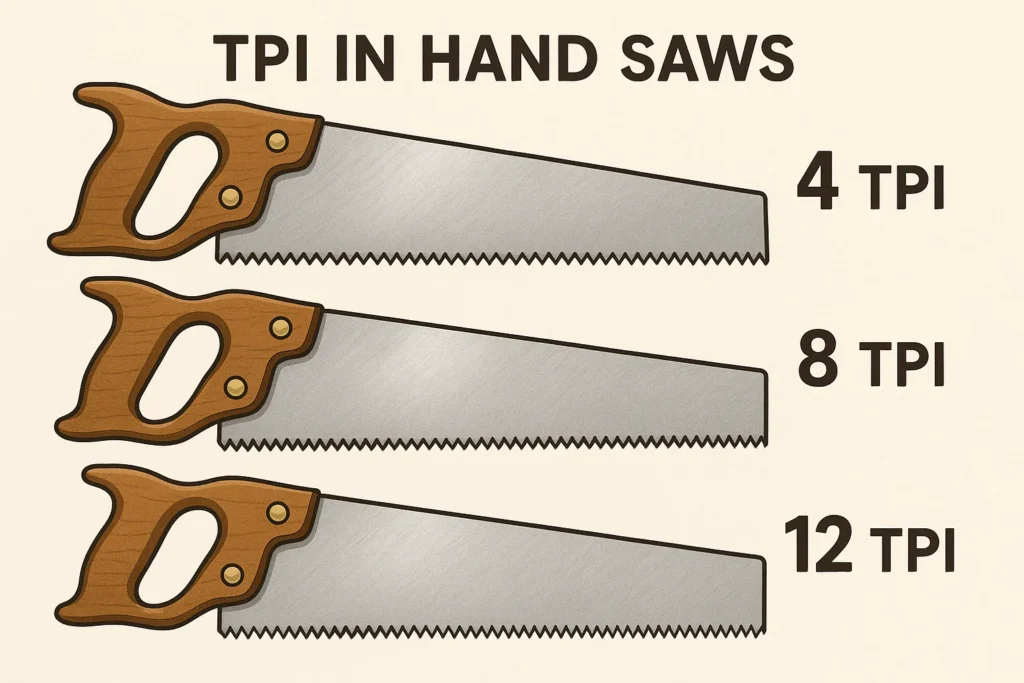
- High TPI (20–32) means smaller teeth and smoother cuts. You remove less wood per stroke, so you get a fine finish.
- Low TPI (14–18) cuts faster but leaves a rougher edge. Only choose this if you plan to sand or file afterward.
- Tooth shape: “Rip” teeth cut along the wood grain; “crosscut” teeth cut across fibers. Most coping saw blades use a hybrid shape for all‐around use.
3. Handle Design and Comfort
- Grip style: A straight handle lets you turn the frame easily. A pistol‐style handle gives more leverage but limits rotation.
- Material: Wood handles feel warm and absorb sweat. Plastic or rubber handles resist moisture and last longer.
- Ergonomics: Look for rounded edges where your palm rests. A lightly textured grip stops slipping.
4. Blade‐Change Mechanism
- Thumb‐screw frame: You loosen a wing nut or thumbscrew to swap blades. It’s simple but slows you down if you change blades often.
- Quick‐release frame: A spring‐loaded pin pops the blade in and out. Faster changes, but more moving parts can wear out.
5. Material Quality and Durability
- Frame material: Steel frames resist bending and hold blade tension. Aluminum frames weigh less but can flex.
- Blade coating: Black oxide or Teflon coatings reduce rust and help sawdust fall away.
- Build review: Check user feedback for reports of broken frames or dull teeth after a few uses.
How to Use a Coping Hand Saw?
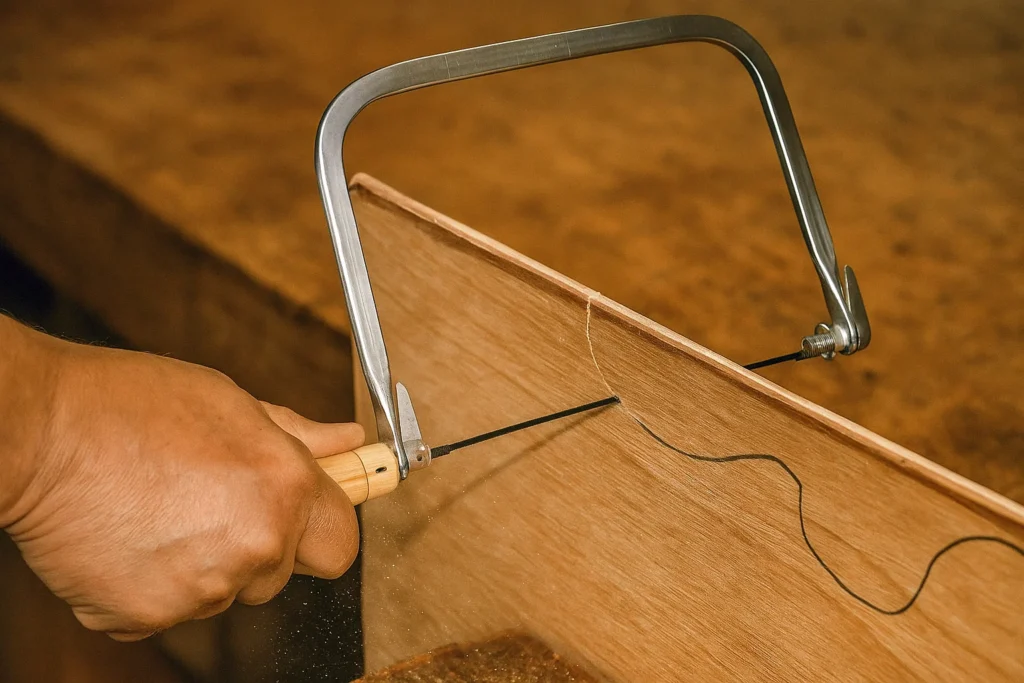
Using a coping saw well takes setup, steady motion, and the right finishing touches. Follow these steps to get clean, precise cuts every time.
1. Secure and Position the Workpiece
- Clamp it down: Use a bench vise or C‑clamps to hold your molding or trim firmly. A moving piece can ruin a fine cut.
- Align the cut line: Let the saw blade hang just above your pencil mark. This ensures you remove waste, not the final shape.
2. Marking and Starting the Cut
- Draw the profile: Use a coping template or cut a test piece to trace the exact shape onto your workpiece.
- Drill a starter hole (optional): For deep interior cuts, a small drill bit makes it easier to insert the blade. Choose a bit just large enough for the blade to pass through.
- Insert the blade: Rotate the blade so teeth point toward the handle. Push it through the hole or slide it under the work if you start at an edge.
3. Holding and Guiding the Saw
- Grip: Hold the handle with four fingers and rest your thumb on the frame. This gives control without straining your wrist.
- Blade angle: Tilt the blade 5–10 degrees away from vertical. This puts more tooth contact on the side of the cut that stays, reducing splintering.
- Body position: Stand so your shoulder, elbow, and wrist align. This straight line of force makes the cut smooth.
4. Cutting Technique and Rhythm
- Light forward stroke: Push the blade gently into the wood—let the teeth do the work.
- Firm back stroke: Draw the blade back to clear sawdust and reset the cut.
- Steady pace: Aim for 15–20 strokes per minute. Rushing can bend the blade or veer off line.
- Watch the kerf: Keep the blade in the waste area outside your final line; this prevents accidental overcut.
5. Following Curves and Profiles
- Rotate the frame, not your wrist: To turn corners, twist the U‑frame gently, keeping the blade under tension.
- Small arcs: For tight curves, shorten strokes to stay on the line.
- Check progress: Stop every few strokes and compare the cut edge to your template. This spot check saves rework later.
6. Finishing Touches
- Smooth edges: Use a fine file or sandpaper to remove any tear‑out or tiny bumps.
- Test fit: Place your coped piece against its mating surface. It should fit flush without gaps.
- Adjust if needed: Lightly trim high spots with the saw or file, checking fit after each pass.
Mastering these steps clears away uncertainty. Secure the work, guide the blade with care, and refine the cut—then your coping saw becomes a precision tool you trust
Conclusion
Coping saws are simple but powerful tools for detailed cuts in trim, molding, and crafts.
Whether you want high blade tension, quick changes, or a budget-friendly option, there’s a model to match your needs.
Each saw on this list offers unique strengths, so pick the one that fits your project style and comfort.
A good coping saw doesn’t just cut—it helps you make clean, professional joints that last.
The Super‑Skin MK IV coping saw offers precise, fatigue‑free cuts with instant tension control and full 180° blade rotation. Its lightweight frame and included fine blades make it ideal for detailed woodworking.
If you see any kind of mistake in our content, make sure to reach out to us.
Frequently Asked Questions (FAQs)
What type of saw is a coping saw?
A coping saw is a small hand saw with a thin, narrow blade held in a U‑shaped frame. It’s made for cutting tight curves and interior shapes in wood, especially for fitting trim and molding pieces together.
What is the best TPI for a coping saw?
Most fine‑cut work uses 20–32 teeth per inch (TPI) for smooth edges and precise detail. If you need faster cuts and don’t mind a rougher finish, a blade in the 14–18 TPI range can work, but you may need to sand or file afterward.
Is a hacksaw a coping saw?
No. A hacksaw has a deeper frame and a blade designed for cutting metal or plastic, not fine wood shapes.
Though both use thin blades under tension, a coping saw’s blade is finer and its frame lets you rotate the blade to follow curves.
What makes a good coping saw?
- Sturdy frame that holds tension without flexing.
- Easy blade‑change system (quick‑release or large thumbscrew).
- Comfortable handle that lets you turn the frame without hand strain.
- Appropriate blade choices: correct TPI, 0.02–0.03 inch thick for curves, thicker for straighter cuts.
- Durable finish on frame and blades to resist rust and wear.
The Grain Bros was started to serve woodworkers who can’t find products for their specific use case. We found out that there are not many media outlets extensively covering this topic. That’s why, we are here, to do the research and find the perfect products for your next DIY project. So you don’t have to juggle your tools and laptop at the same time.
If you see any kind of mistake in our content, make sure to reach out to us.





